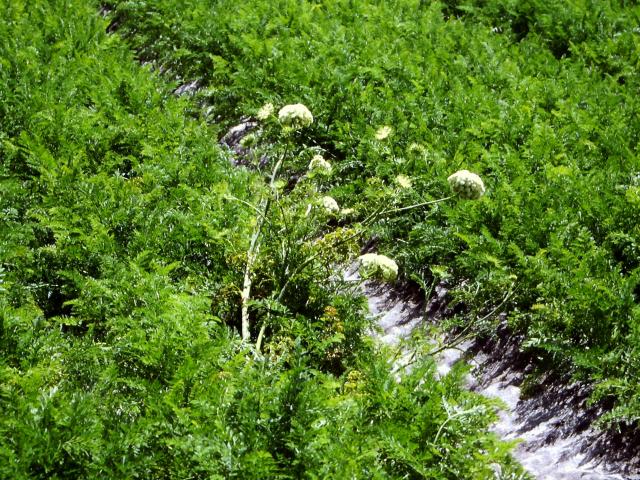Spread
CarVY is spread by aphids in a non-persistent manner. Aphids rapidly acquire the virus when feeding on infected carrot plants and then just as rapidly lose the virus from their mouthparts after feeding on a healthy or non-host plant.
A range of aphid species can transmit CarVY, including species that do not normally colonise carrots. The green peach aphid (Myzus persicae) is a very efficient vector. Volunteer carrots and nearby carrot crops infected with CarVY are the main sources of virus for spread to newly planted crops.
Other apiaceous host crops such as anise, chervil, dill, coriander, cumin and parsnip are potential alternative virus sources. Some native apiaceaous plants may be other sources, but this has not been confirmed. As CarVY has a very narrow host range, it is unlikely that weeds and crop plants that do not belong to the Apiaceae family are a source of infection.
Whether CarVY is seed-borne at very low levels is yet to be confirmed but other similar viruses belonging to the same virus family are seed-borne at low levels. If it is seed-borne, this would provide a means of introduction of the virus to new sites.
Control
Once a carrot plant becomes infected with CarVY, there is no cure. The best means of control is adopting management practices that minimise the reservoir of infection. If the following integrated control strategy is followed, infection will be greatly reduced:
- Avoid side-by-side plantings of carrots, grow an intervening non-host crop or have the bordering area under fallow.
- Having side by side plantings of carrots of different ages leads to the younger crops being infected from older, nearby virus-infected ones. Planting a barrier non-host crop or having a fallow area around the crop will reduce virus spread.
- Planting an intervening non-host barrier crop helps more than leaving the intervening area fallow because virus-carrying aphids may land on the non-host crop before arriving at the carrot crop. By probing a non-host plant first aphids lose the virus from their mouthparts and so lose their potential to spread virus when they move on to the carrot crop.
- Destroy all volunteer carrots and any finished crops (Figure 3).
- Carrots that remain after the crop has been harvested may be infected with CarVY and act as a source for its spread to newly sown crops. Crops that are finished or abandoned should immediately be ploughed in, well below the soil surface.
- Monitor aphid numbers, manipulate the sowing date so that young carrot seedlings are not present during peak aphid periods and protect the crop with insecticides while the crop is young.
- It is important to monitor the area for aphid numbers by trapping. Try to avoid planting during peak aphid population times. If young seedlings (up to six weeks old) are infected with CarVY, they develop severe root symptoms. Peak aphid population times occur for short periods in spring and autumn.
- Sequential plantings of carrots all year round are often associated with CarVY outbreaks, so this type of planting should be avoided. Having a fallow period after harvest will greatly reduce the likelihood of an epidemic. If a non-host crop is grown in rotation, the area can still be productive while removing the source of CarVY infection.
Acknowledgement
This information is based on earlier DAFWA and Horticulture Australia Limited (HAL) supported research and extension conducted by Lindrea Latham, Lisa Smith and Roger Jones.

